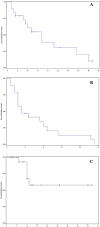Hypofractionated image-guided breath-hold SABR (stereotactic ablative body radiotherapy) of liver metastases--clinical results
- PMID: 22710033
- PMCID: PMC3464721
- DOI: 10.1186/1748-717X-7-92
Hypofractionated image-guided breath-hold SABR (stereotactic ablative body radiotherapy) of liver metastases--clinical results
Abstract
Purpose: Stereotactic Ablative Body Radiotherapy (SABR) is a non-invasive therapy option for inoperable liver oligometastases. Outcome and toxicity were retrospectively evaluated in a single-institution patient cohort who had undergone ultrasound-guided breath-hold SABR.
Patients and methods: 19 patients with liver metastases of various primary tumors consecutively treated with SABR (image-guidance with stereotactic ultrasound in combination with computer-controlled breath-hold) were analysed regarding overall-survival (OS), progression-free-survival (PFS), progression pattern, local control (LC), acute and late toxicity.
Results: PTV (planning target volume)-size was 108 ± 109cm3 (median 67.4 cm3). BED2 (Biologically effective dose in 2 Gy fraction) was 83.3 ± 26.2 Gy (median 78 Gy). Median follow-up and median OS were 12 months. Actuarial 2-year-OS-rate was 31%. Median PFS was 4 months, actuarial 1-year-PFS-rate was 20%. Site of first progression was predominantly distant. Regression of irradiated lesions was observed in 84% (median time to detection of regression was 2 months). Actuarial 6-month-LC-rate was 92%, 1- and 2-years-LC-rate 57%, respectively. BED2 influenced LC. When a cut-off of BED2 = 78 Gy was used, the higher BED2 values resulted in improved local control with a statistical trend to significance (p = 0.0999). Larger PTV-sizes, inversely correlated with applied dose, resulted in lower local control, also with a trend to significance (p-value = 0.08) when a volume cut-off of 67 cm3 was used.No local relapse was observed at PTV-sizes < 67 cm3 and BED2 > 78 Gy. No acute clinical toxicity > °2 was observed. Late toxicity was also ≤ °2 with the exception of one gastrointestinal bleeding-episode 1 year post-SABR. A statistically significant elevation in the acute phase was observed for alkaline-phosphatase; in the chronic phase for alkaline-phosphatase, bilirubine, cholinesterase and C-reactive protein.
Conclusions: A trend to statistically significant correlation of local progression was observed for BED2 and PTV-size. Dose-levels BED2 > 78 Gy cannot be reached in large lesions constituting a significant fraction of this series. Image-guided SABR (igSABR) is therefore an effective non-invasive treatment modality with low toxicity in patients with small inoperable liver metastases.
Figures




Similar articles
-
Clinical outcome of hypofractionated breath-hold image-guided SABR of primary lung tumors and lung metastases.Radiat Oncol. 2014 Jan 8;9:10. doi: 10.1186/1748-717X-9-10. Radiat Oncol. 2014. PMID: 24401323 Free PMC article.
-
Flattening-filter-free intensity modulated breath-hold image-guided SABR (Stereotactic ABlative Radiotherapy) can be applied in a 15-min treatment slot.Radiother Oncol. 2013 Dec;109(3):505-9. doi: 10.1016/j.radonc.2013.09.014. Epub 2013 Oct 12. Radiother Oncol. 2013. PMID: 24128805
-
Image-guided stereotactic ablative radiotherapy for the liver: a safe and effective treatment.Eur J Surg Oncol. 2015 Feb;41(2):249-56. doi: 10.1016/j.ejso.2014.10.053. Epub 2014 Nov 1. Eur J Surg Oncol. 2015. PMID: 25468743
-
The Emerging Role of Stereotactic Ablative Radiotherapy for Primary Renal Cell Carcinoma: A Systematic Review and Meta-Analysis.Eur Urol Focus. 2019 Nov;5(6):958-969. doi: 10.1016/j.euf.2019.06.002. Epub 2019 Jun 24. Eur Urol Focus. 2019. PMID: 31248849
-
Prostate-specific membrane antigen-positron emission tomography/computed tomography (PSMA-PET/CT)-guided stereotactic ablative body radiotherapy for oligometastatic prostate cancer: a single-institution experience and review of the published literature.BJU Int. 2019 Nov;124 Suppl 1:19-30. doi: 10.1111/bju.14886. Epub 2019 Sep 11. BJU Int. 2019. PMID: 31507035 Review.
Cited by
-
Direct dose correlation of MRI morphologic alterations of healthy liver tissue after robotic liver SBRT.Strahlenther Onkol. 2018 May;194(5):414-424. doi: 10.1007/s00066-018-1271-9. Epub 2018 Feb 5. Strahlenther Onkol. 2018. PMID: 29404626 English.
-
Study protocol of the LARK (TROG 17.03) clinical trial: a phase II trial investigating the dosimetric impact of Liver Ablative Radiotherapy using Kilovoltage intrafraction monitoring.BMC Cancer. 2021 May 3;21(1):494. doi: 10.1186/s12885-021-08184-x. BMC Cancer. 2021. PMID: 33941111 Free PMC article.
-
Dose to organ at risk and dose prescription in liver SBRT.Rep Pract Oncol Radiother. 2017 Mar-Apr;22(2):96-102. doi: 10.1016/j.rpor.2017.03.001. Epub 2017 Apr 17. Rep Pract Oncol Radiother. 2017. PMID: 28490979 Free PMC article. Review.
-
Clinical results of mean GTV dose optimized robotic guided SBRT for liver metastases.Radiat Oncol. 2016 May 28;11:74. doi: 10.1186/s13014-016-0652-4. Radiat Oncol. 2016. PMID: 27236333 Free PMC article.
-
CT Imaging Findings after Stereotactic Radiotherapy for Liver Tumors.Gastroenterol Res Pract. 2015;2015:126245. doi: 10.1155/2015/126245. Epub 2015 Jun 29. Gastroenterol Res Pract. 2015. PMID: 26221135 Free PMC article.
References
-
- Timmerman RD, Bizekis CS, Pass HI. et al.Local surgical, ablative, and radiation treatment of metastases. CA Cancer J Clin. 2009;59:145–170. - PubMed
-
- Blomgren H, Lax I, Naslund I, Svanstrom R. Stereotactic high dose fraction radiation therapy of extracranial tumors using an accelerator. Clinical experience of the first thirty-one patients. Acta Oncol. 1995;34:861–870. - PubMed
-
- Herfarth KK, Debus J, Lohr F. et al.Stereotactic single-dose radiation therapy of liver tumors: results of a phase I/II trial. J Clin Oncol. 2001;19:164–170. - PubMed
-
- Kavanagh BD, Schefter TE, Cardenes HR. et al.Interim analysis of a prospective phase I/II trial of SBRT for liver metastases. Acta Oncol. 2006;45:848–855. - PubMed
-
- McCammon R, Schefter TE, Gaspar LE, Zaemisch R, Gravdahl D, Kavanagh B. Observation of a dose-control relationship for lung and liver tumors after stereotactic body radiation therapy. Int J Radiat Oncol Biol Phys. 2009;73:112–118. - PubMed
Publication types
MeSH terms
LinkOut - more resources
Full Text Sources
Medical
Research Materials

